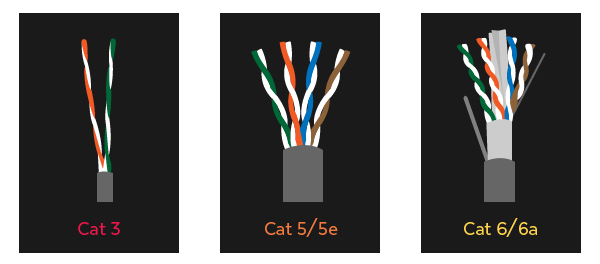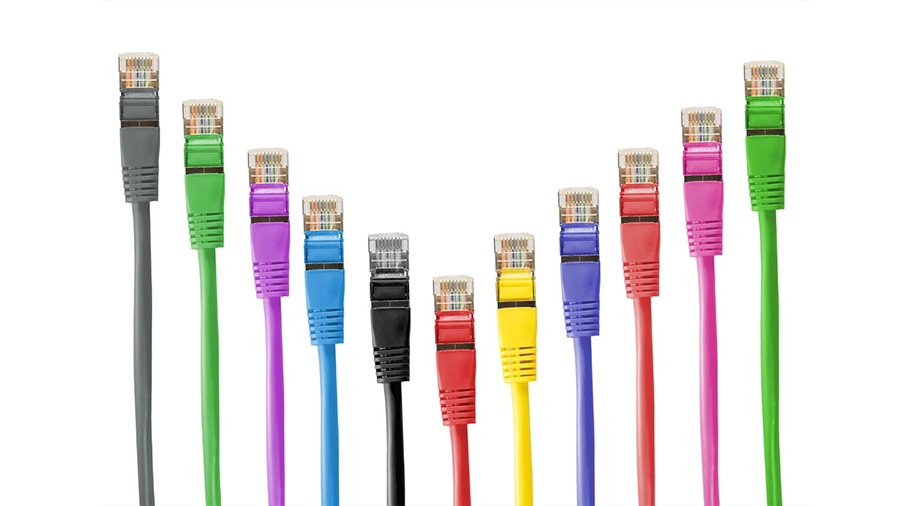Different Ethernet Categories
| Cable Category | Cable Type | Max. Data Transmission Speed | Max. Bandwidth | Ethernet Standard |
|---|---|---|---|---|
| Cat 1 | UTP | 1 Mbps | 1MHz | Not used for data |
| Cat 2 | UTP | 4 Mbps | 10MHz | Token Ring |
| Cat 3 | UTP | 10 Mbps | 16MHz | 10BASE-T |
| Cat 4 | UTP | 20 Mbps | 20MHz | Token Ring |
| Cat 5 | UTP | 100 Mbps | 100MHz | 100BASE-T |
| Cat 5e | UTP | 1000 Mbps | 100MHz | 1000BASE-T |
| Cat 6 | UTP or STP | 10 Gbps | 250MHz | 10GBASE-T |
| Cat 6a | STP | 10 Gbps | 500MHz | 10GBASE-T |
| Cat 7 | STP or FTP | 10 Gbps | 600MHz | Not drafted yet |
Notes:
* 1 Gbps = 1000 Mbps
UTP, STP and FTP? Learn more about ethernet cable types Here.
Ethernet Cables Categories in more Detail
Category 1
This cable contains only two pairs (4 wires). This cable was used in the telephone network for voice transmission.
Category 2
This cable and all further cables have a minimum of 8 wires (4 pairs). This cable was used in the token-ring network.
Category 3
Cat3 cable is an earlier generation of Ethernet but can still be seen in older deployments. With the ability to support a maximum frequency of 16 MHz, this type of Ethernet can still be used for two-line telephone systems and 10BASE-T networks. CAT3 cable can also be used for alarm system installation or similar applications. CAT3 cable can have 2, 3, or 4 copper pairs (though uncommon). Category 5e cable, however, has become the default Ethernet category of choice with the ability to support faster speeds and frequencies.
Category 4
This cable was used in advanced Token-ring networks.
Category 5
Cat5 Ethernet, introduced 10/100 Mbps Ethernet over distances of up to 100 meters, also known as Fast Ethernet. Even though some older deployments still use CAT5 cable, it is now considered obsolete and has since been replaced by Cat5e.
Category 5e
Though Cat5 and Cat5e cables are physically similar, Category 5e Ethernet adheres to more stringent IEEE standards. “E” is for enhanced, meaning a lower-noise version where the potential for crosstalk is reduced. Crosstalk is interference that transfers from adjacent wires.
Cat5e is the most common type of cabling used for deployments due to its ability to support Gigabit speeds at a cost-effective price. Even though both Cat5 and Cat5e support a maximum frequency of up to 100MHz, Cat5e has completely replaced its predecessor. Gigabit Ethernet utilizes 4 data pairs in comparison to Fast Ethernet which utilizes 2 data pairs.
Further, Cat 5e supports speeds of up to 1000 Mbps. It’s flexible enough for small space installations like residences, though it is still used in commercial spaces. Of all the current cabling options, Cat5e is your least expensive option.
Category 6
Cat6 wiring can support up to 10 Gbps and frequencies of up to 250 MHz. While Cat5e cable features 1.5-2 twists per cm, Cat6 cables are more tightly wound and feature 2 or more twists per cm. (The amount of twists per cm varies upon each cable manufacturer).
Cat6 cables also sport thicker sheaths in comparison to Cat5e. Though standard Ethernet supports distances of up to 100 meters, CAT6 cable only supports 37-55 meters (depending on crosstalk) when transmitting 10 Gbps speeds. Its thicker sheath protects against Near End Crosstalk (NEXT) and Alien Crosstalk (AXT).
Even though Cat6 and Cat6a cabling offer higher performance rates, many LANs still opt for CAT5e due to its cost-effectiveness and ability to support Gigabit speeds.
Category 6a
Cat6a supports bandwidth frequencies of up to 500 MHz, twice the amount of Cat6 cable, and can also support 10Gbps like its predecessor. However, unlike Cat6 cabling, Cat6a can support 10 Gigabit Ethernet at 100 meters. [Cat6 cabling on the other hand, can transmit the same speeds at up to 37 meters.]
Cat6a also features more robust sheathing which eliminates alien crosstalk (AXT) and improves upon the signal-to-noise ratio (SNR). “A” = augmented. The stronger sheathing makes Cat6a cabling considerably thicker than Cat6, also making it less flexible to work with, and therefore, better suited for industrial environments at a lower price point.
Category 7
Cat7 can also support 10 Gbps, but laboratory testing has successfully shown its ability to transmit up to 40 Gb at 50 meters and even 100 Gb at 15 meters. The newer “Class F” cabling can support frequencies of up to 600 Mhz. That said, Cat7 has not been approved as a cable standard for telecommunications.
Cat7 offers extensive shielding to reduce signal attenuation and is relatively stiff in comparison to previous generations of cabling. Both individual pairs are shielded, with an additional layer of shielding over the entire cable. The shielding needs to be grounded and Cat7 also requires special GigaGate45 (GG45) connectors to take full advantage of higher performance features.
All in all, Cat6a can perform just about the same as Cat7 but at a lower price point. Most of our AV and IP surveillance customers opt for Cat6a STP or Cat6a FTP. Both offer shielding from alien crosstalk and interference around high voltage lines.
Cat7 is suited for use in datacenters and large enterprise networks.
Category 8
Cat8 cable is still in the development stage and not yet ratified. According to the 2016 Ethernet Alliance Roadmap, it will be able to support 25GB and 40Gb Ethernet. Cat8 will be able to support even faster transmission rates at distances of up to 30 meters.
Category Cable Wiring


